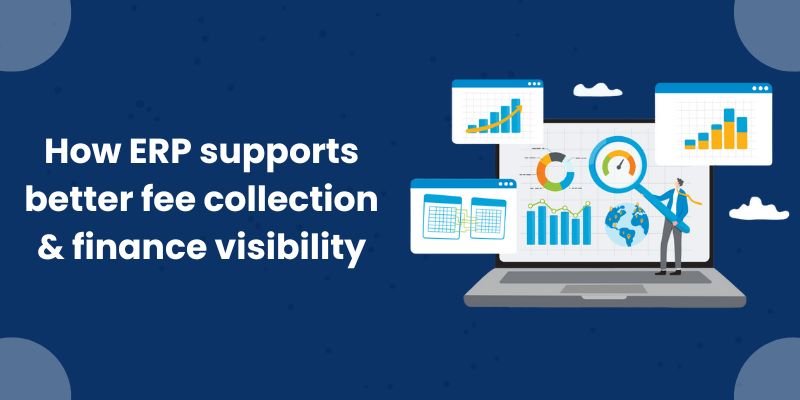The Reality of School Finance Management
Managing finances in schools, particularly fee collection, is often one of the most time-consuming and error-prone aspects of administration. From tracking payments to issuing receipts and reconciling accounts, the traditional approach – relying heavily on registers, spreadsheets, and manual intervention—can quickly become overwhelming.
As educational institutions scale and expectations rise, there is an urgent need for systems that offer not just efficiency, but transparency and accuracy. This is where an ERP (Enterprise Resource Planning) solution becomes not just helpful, but essential.
Common Challenges in School Fee Collection
Most schools struggle with similar issues when it comes to collecting fees:
- Parents forgetting due dates or misplacing payment receipts
- Administrative staff spending excessive time on repetitive tasks
- Variations in fee structures across classes or categories
- Difficulty tracking payments and generating accurate financial reports
- Lack of transparency, leading to complaints and distrust
These challenges can delay collections, reduce accountability, and negatively impact the financial health of an institution.
The Role of ERP in Streamlining Fee Collection
Automated Fee Scheduling and Structure Management
A comprehensive ERP system allows institutions to define and automate fee structures across different parameters—monthly, term-wise, annually, or based on student categories such as transport users, hostel residents, or scholarship holders. The system calculates dues automatically and generates bills accordingly, eliminating manual entry errors and ensuring consistency across the board.
Timely Reminders and Notifications
One of the most common reasons for fee delays is the absence of timely reminders. ERP platforms automatically notify parents about upcoming or overdue payments through SMS, email, or in-app alerts. These reminders are sent at strategic intervals—when a fee is generated, before the due date, and in the event of non-payment—ensuring that parents stay informed and payment defaults are minimized.
Digital Payment Integration
ERP solutions enable seamless digital transactions by integrating secure payment gateways. Parents can make payments through UPI, net banking, debit/credit cards, or digital wallets, all from within the ERP portal or mobile app. This reduces the need for physical visits to the school and ensures that payments are logged and acknowledged instantly.
Instant Receipts and Payment Confirmation
The generation of real-time digital receipts following successful payment is a significant feature of ERP systems. These receipts are timestamped, linked to the student profile, and stored securely in the system, allowing both the school and parents to maintain clear and accessible records. This transparency builds trust and eliminates the common complaint of lost or delayed receipts.
Enhancing Financial Visibility and Control
Comprehensive Dashboards for Real-Time Monitoring
ERP dashboards provide administrators and finance teams with a bird’s-eye view of the institution’s financial status. At a glance, users can see:
- Daily, weekly, and monthly collections
- Outstanding dues by student, class, or department
- Concession and scholarship summaries
- Payment mode distribution and trends
- Fee component-wise revenue breakdown
This real-time access to data helps leadership make informed decisions and improve financial planning.
Managing Concessions and Scholarships
Modern ERP systems are designed to handle the complexity of various fee waivers and discounts. Whether it is staff ward concessions, sibling discounts, or scholarships for meritorious or underprivileged students, the ERP can apply the necessary adjustments automatically and reflect them accurately in the financial reports. This reduces the chances of miscommunication and ensures compliance with institutional policies.
Reconciliation and Audit Readiness
Reconciliation of accounts becomes significantly easier with ERP. Each transaction is recorded digitally and mapped against the school’s ledger, enabling smooth tracking of all incoming and outgoing payments. During audits, all data—complete with receipts, payment history, and fee schedules—can be exported or shared in standardized formats, making the process quicker, more accurate, and less stressful.
A Better Experience for Parents
Transparent and Accessible Information
ERP systems empower parents with access to detailed, up-to-date fee information. Through the parent portal or app, they can:
- View pending dues and due dates
- Review historical payment records
- Download receipts and invoices
- Understand the breakdown of each fee component
This level of transparency enhances communication between the school and parents, reducing disputes and increasing overall satisfaction.
Reducing Administrative Load
Manual handling of fee-related tasks often consumes a large portion of an institution’s administrative resources. With ERP, the process becomes largely automated—reminders, receipts, ledger updates, and reports are all generated without human intervention. This reduces administrative fatigue and allows staff to focus on strategic activities such as improving fee recovery rates and refining financial policies.
Data-Driven Planning and Forecasting
An often-overlooked benefit of ERP systems is their role in long-term planning. With access to historical payment patterns and real-time fee collection data, schools can accurately forecast future revenues, plan budgets more effectively, and even identify opportunities to revise or streamline their fee structures.
By leveraging ERP-generated insights, institutions can move from reactive to proactive financial planning—building resilience, ensuring stability, and driving growth.
A Smarter, More Transparent Finance Ecosystem
Fee collection is not merely a routine administrative task—it is central to a school’s financial health and long-term sustainability. In a time where expectations of professionalism, efficiency, and transparency are higher than ever, traditional methods of fee management fall short.
An ERP solution provides a structured, reliable, and intelligent way to handle all aspects of school finance. From improving collection efficiency and reducing workload to enhancing visibility and boosting parent satisfaction, ERP systems transform financial operations from fragmented to unified, and from chaotic to controlled.
Schools that embrace this technology not only improve internal efficiency but also position themselves as future-ready institutions that value trust, clarity, and operational excellence.












